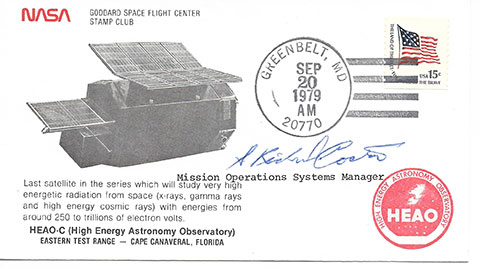Apollo-Soyuz
Member Posts: 1285
From: Shady Side, Md
Registered: Sep 2004
|
 posted 08-01-2021 12:33 AM
posted 08-01-2021 12:33 AM
   
Space Cover of the Week, Week 616, Aug. 1, 2021  Space Cover #616: HEAO-C LaunchThis week's Space Cover of the Week commemorates the launching of HEAO-C, the third High Energy Astronomy Observatory on Sept. 20, 1979 aboard Atlas-Centaur #53. HEAO-C scanned for cosmic ray particles and gamma ray photons. Control of the in orbit HEAO observatories was under the direction of the Marshall Space Flight Center with flight control engineers operating from facilities at the Goddard Space Flight Center. Control of the Data Processing Center, Spaceflight Tracking and Data Network and the Operations Control Center (OCC) was responsibility of Goddard. The above cover was autographed by Mission Operations System Manager, Richard Costa. The Goddard Stamp Club serviced 500 covers for the mission. |
Ken Havekotte
Member Posts: 3279
From: Merritt Island, Florida, Brevard
Registered: Mar 2001
|
 posted 08-01-2021 05:06 PM
posted 08-01-2021 05:06 PM
   
It was good seeing your post, John, in commemoration of the HEAO-C launch here from the Cape in Sept. 1977. This particular mission, along with a series of two others, were some of my first news media (press) assignments for a space journal magazine. At that time during the mid/late 1970's, all three HEAO flights I was fortunate enough to cover "live" from the Cape Canaveral AFS (now renamed the Cape Canaveral Space Force Station). The three Atlas-Centaur flights from 1977-79 were some of my earlier rubber stamp cachet designed postal covers. Below are a number of different HEAO launch day covers. At the top left is one of my earlier rubber stamp cachet design attempts, as referred to above, with a simple and somewhat primitive, or crude, 3-colored RSC with a single launch vehicle illustration along with only 4 words! The 1970's were mainly an "experiment time" for starting my own space cover cachet and cancel service to collectors worldwide as I was just out of high school and attending college.  The blue RSC at top right, and nicely done, is a favorite of mine as the simplicity of it is so well done. At the moment, though, I can't recall the cachet maker of it. Do you know John? The other cachet covers represent different cachet producers for all three of the high energy astrophysical observatories. The one signed by launch director George Page is a Centennial Covers design by Ed Hacker of Huntsville, AL. The attractive add-on silk cachet was created by John Zaso of New Hyde Park, NY. It was #7 in a special series for members of the International Association of Space Philatelists (IASP). Two others included are by TRW Defense and Space Systems Group of Redondo Beach, CA, and classify as official aerospace contractor cover types. The last cover pictured at bottom right is a popular cachet cover artwork format by legendary space cover designer and dealer Robert Rank (Space Voyage Covers) of Union City, NJ. The 6,000(+)-pound satellite observatories, built by TRW for NASA's Marshall Space Flight Center in Huntsville, AL, helped scientists to understand how X-rays and gamma rays are produced in deep space. The very large series of orbiting astronomy observatories provided new knowledge about pulsars, quasars, exploding galaxies, and black holes in space. HEAO-B (#2) was even named the Einstein Observatory after its launch in Nov. 1978 and was the first fully imaging X-ray telescope put into space. It was a key mission in X-ray astronomy studies and its scientific outcome completely changed the view of the X-ray sky and discovered thousands of "serendipitous" sources. |













